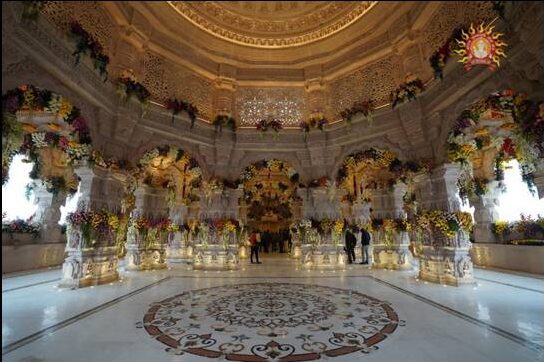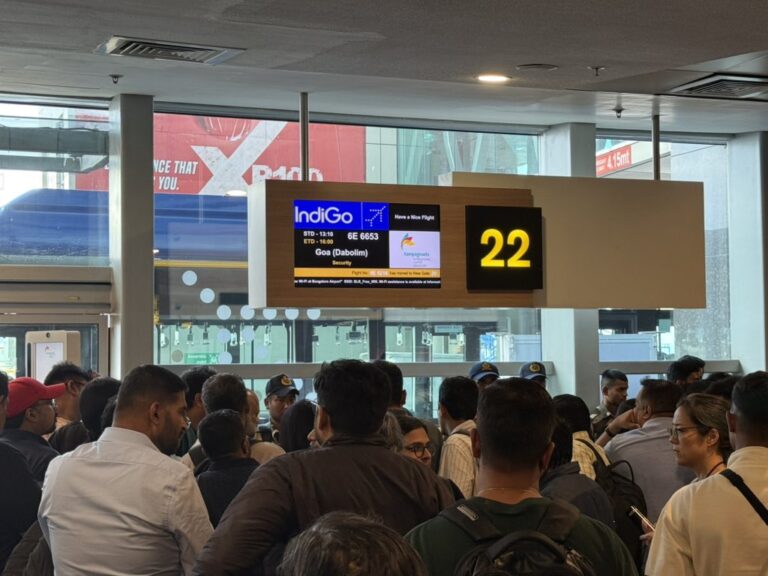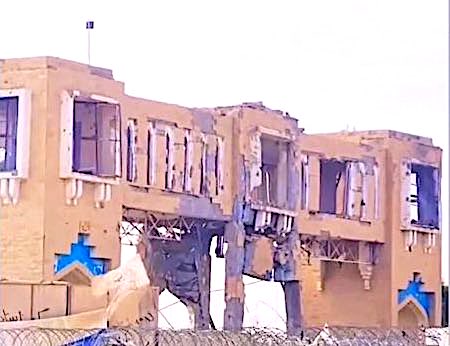
Ayodhya: The new Ram Mandir in Ayodhya is standing tall not just in grandeur, but also in the tapestry of contributions woven across states. It is here that Prime Minister Narendra Modi will participate in the Pran Pratishtha (consecration) ceremony of Shri Ramlalla at around noon on January 22, 2024. It was in October 2023, when the Prime Minister received the invitation from Shri Ram Janmbhoomi Trust for the Pran Pratishtha ceremony.
The magnificent Shri Ram Janmbhoomi Mandir is constructed in traditional Nagara style. Its length (east-west) is 380 feet; width is 250 feet and height is 161 feet; and is supported by a total of 392 pillars and 44 doors. The pillars and walls of the temple showcase intricately sculpted depictions of Hindu deities, gods, and goddesses. In the main sanctum sanctorum on the ground floor, the childhood form of Bhagwan Shri Ram (the idol of Shri Ramlalla) has been placed.
The foundation of the temple has been constructed with a 14-meter-thick layer of roller-compacted concrete (RCC), giving it the appearance of artificial rock. The temple has been constructed employing the country’s traditional and indigenous technology. Cement or iron and steel is not used anywhere in its construction. For protection against ground moisture, a 21-foot-high plinth has been constructed using granite. The temple complex has a sewage treatment plant, water treatment plant, water supply for fire safety and an independent power station.
The main temple building, which is 360 feet long, 235 feet wide and 161 feet high, is made of sandstone quarried from Bansi Pahadpur, Rajasthan.
The main entrance to the temple is situated on the eastern side, which can be approached by ascending 32 stairs through the Sinh Dwar.
There are a total of five Mandaps (Halls) in the Mandir – Nritya Mandap, Rang Mandap, Sabha Mandap, Prathana Mandap and Kirtan Mandap. Near the temple is a historic Well (Sita koop), dating back to the ancient era. In the southwestern part of the temple complex, at Kuber Tila, the ancient temple of Lord Shiv has been restored, along with the installation of a statue of Jatayu.
The core of the new Ram temple stands majestic, covered in the pristine white elegance of Rajasthan’s Makrana marble. Karnataka’s Charmouthi sandstone, when it comes to the exquisite carvings of deities, takes centre stage. While pink sandstone from Rajasthan’s Bansi Paharpur has been utilized in the entrance gate’s imposing figures.
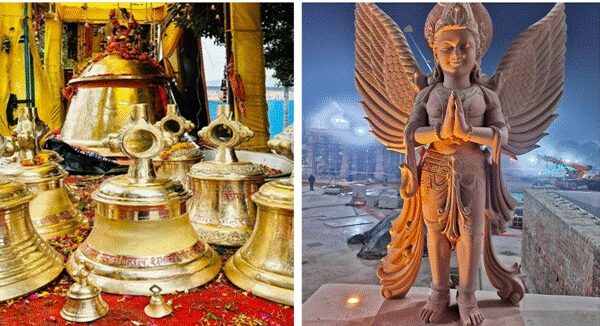
The contributions go far beyond building materials. Gujarat gifted a majestic 2100 kg Ashtadhatu bell as well as a 700 kg chariot carrying a special ‘nagada‘ crafted by the All India Darbar Samaj.
The black stone used for Lord Ram’s idol originates from Karnataka. From the Himalayan foothills, Arunachal Pradesh and Tripura have offered intricately carved wooden doors and handcrafted fabrics, standing as gateways to the divine realm.
The list of contributions doesn’t end here. Brassware, hails from Uttar Pradesh, while polished teakwood, arrives from Maharashtra.
Besides, the construction of the temple has been technically assisted by at least four leading National Institutes of CSIR (Council of Scientific & Industrial Research) and DST (Department of Science & Technology) under the Ministry of Science & Technology, in addition to certain inputs from other institutions like Indian Institutes of Technology (IITs) as well as the Indian Space Research Organisation(ISRO). The four institutes which made a significant contribution include CSIR -Central Building Research Institute (CBRI) Roorkee; CSIR – National Geophysical Research Institute (NGRI) Hyderabad; DST – Indian Institute of Astrophysics (IIA) Bengaluru and CSIR-Institute of Himalayan Bioresource Technology (IHBT) Palampur (HP).
CSIR-CBRI Roorkee majorly contributed towards Ram Temple construction while CSIR-NGRI Hyderabad gave significant inputs on foundation design and seismic safety. The 3-storey temple can withstand strong tremors of magnitude 8 on the Richter scale for as long as 2,500 years.
The DST-IIA Bengaluru provided technical support on Sun’s path and optical for Surya Tilak which is a unique feature of the Ram Temple. It is designed in such a way that the Sun rays will fall on the forehead of Lord Ram’s Idol at 12 noon on the Ram Navami day every year for about 6 minutes. Ram Navami, celebrated on the ninth day of the first month of the Hindu calendar, which is usually in March-April, marks the birthday of Lord Rama, the seventh incarnation of Lord Vishnu. Gearbox and reflective mirrors/lenses have been arranged such that sun rays from the third floor near shikara will be brought to the Garbha Griha using well-known principles of tracking the Sun’s path.
The CSIR-IHBT Palampur made tulips bloom for the divine Ram Mandir Pran Pratishtha ceremony in Ayodhya on January 22, 2024. It may be mentioned that Tulips do not flower in this season. They grow only in Jammu and Kashmir and a few other higher Himalayan regions and that too only in the spring season. The IHBT Palampur recently developed an indigenous technology through which tulips could be made available throughout the year, without waiting for their season.
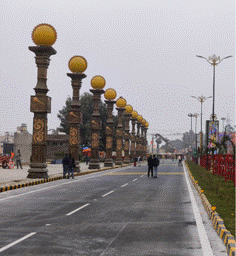 But the story of the Ram Mandir is not just about materials and geographical origins. It’s about the countless thousands of talented craftsmen and artisans who have poured their hearts, souls, and skills into this endeavour.
But the story of the Ram Mandir is not just about materials and geographical origins. It’s about the countless thousands of talented craftsmen and artisans who have poured their hearts, souls, and skills into this endeavour.
For generations, Ayodhya has resonated with religious significance, serving as the birthplace of Lord Ram and acting as a spiritual hub for millions worldwide. The Ram Mandir is not just a monument in Ayodhya; it’s a living testament to the unifying power of faith.
However, Ayodhya’s transformation extends beyond the temple project. As Rajesh Kumar Gupta, a shop owner from Ayodhya, said, before the temple construction, there was hardly any demand for his goods and his income was meagre. However, in recent times, Ayodhya became a hub of pilgrims and tourists, which increased the demand for his goods and subsequently, his income has seen a surge. He says that he used to make only ₹300-400 a day, but after the grand Ram temple was announced, his income soared to ₹1000-1500 a day.
The redevelopment of Ayodhya’s infrastructure and the investment in the tourism sector demonstrate a holistic approach to the city’s transformation. By improving connectivity, enhancing the visitor experience, and preserving its cultural heritage, Ayodhya is poised to become a thriving centre of pilgrimage, tourism, and economic prosperity.
– global bihari bureau


